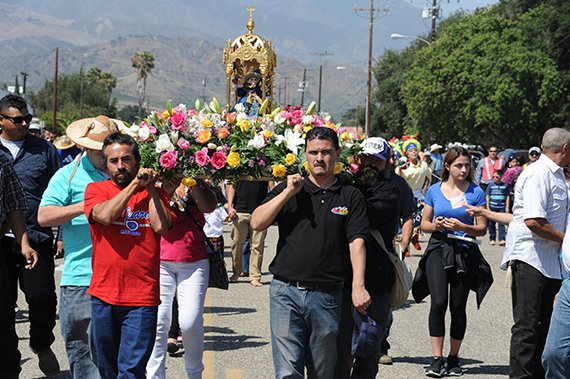
|
Hundreds gathered in front of Harding Park on Saturday to pay their respects to El Santo Niño de Atocha. Above, devotees participate in carrying El Santo Niño de Atocha at the beginning of the procession that ended at Our Lady of Guadalupe Church. |
El Santo Niño de Atocha: Hundreds of excited worshipers welcome icon
June 01, 2016
By Peggy Kelly
Santa Paula News
Hundreds of excited worshipers welcomed one of Santa Paula’s favorite saints, El Santo Niño de Atocha on Saturday with a grand procession for the icon from Harding Park to Our Lady of Guadalupe Church.
The doll of The Holy Child of Atocha, nicknamed El Niño Azul because its usual garb is blue, was held aloft on a bed of flowers for the procession that included Mayor Martin Hernandez, Vice Mayor Jenny Crosswhite and Councilman John Procter.
This is the 10th year that El Santo Niño — the third most cherished icon in Mexico — has been on loan from its shrine in Plateros, Mexico.
The sacred doll will be enshrined in Santa Paula until Sunday to allow visits by pilgrims including those who find Southern California closer than Plateros, home of the original icon.
Some years the welcoming procession for the saint has drawn as many as 5,000 people but this year said Police Chief Steve McLean “It’s a holiday weekend that kept the crowd smaller...everybody goes camping.”
But as vacationers return to the city there is little doubt that El Santo Niño will continue to draw crowds to the church that will attend special Masses, give offerings and pray for miracles.
It was Father Charles Lueras, known at the church as Padre Carlos, who first organized the effort to have the replica image visit Our Lady of Guadalupe. He also accompanied “The Little Saint” on the procession, which wound its way through city streets closed to allow passage for the icon and its entourage.
Aztec dancers, brass bugle and drum corps, Folklorico troupes, equestrians with dancing horses and more led the way for The Holy Child of Atocha who was greeted with cries of joy and prayers.
Francisco Arellano of North Hollywood, at the parade with his wife and children, said it was his first visit to see the arrival of The Little Saint.
“It’s beautiful,” he said of the procession Arellano said had been urged by his brother-in-law. “We’ll be back next year!”
Several in the crowd wore El Niño Azul T-shirts, the nickname of The Little Saint whose attire is traditionally blue in Renaissance style.
At the end of the procession when asked for a crowd estimate SPPD Det. Shane Norwood noted, “I’ve been following the same crowd up!” to the church.
The celebration continued at Our Lady of Guadalupe where parishioners eagerly offered handmade outfits for The Little Saint to be changed into and the kitchen and courtyards filled with those getting something to eat before the Mass began.
The icon will be in Santa Paula until June 5 when the 3 p.m. farewell procession to Las Piedras Park will end with a 4 p.m. Mass celebrated by the Most Rev. Jose H. Gomez, the Archbishop of Los Angeles.
Our Lady of Guadalupe Church is located at 427 N. Oak St.
Father Aureo Gerardo Armas Garcia, OFM Basilica of Our Lady of Zapopan, will lead the Novenas.
Novena Mass in Spanish will be held weekdays at 7 p.m. and on Saturday, June 4, Masses will be held at 9 a.m., noon, 3 p.m. and 6 p.m. On Sunday, June 5 leading up to the 4 p.m. Farewell Mass, Mass will be held at 8 and 10 a.m. (English), 11:30 a.m. and 1 p.m. Night Vigil Mass will be at 8 p.m. on the last day of the Novena.
The history of the icon dates back to the 13th Century when the now lost town of Atocha, Spain, was conquered by invading forces.
The story goes that many Christians were taken prisoner and often denied food by their captors, but the young children of those jailed were allowed to bring meals. The women of the village prayed before the statue of Our Lady of Atocha — a title under the Blessed Virgin Mary — at a nearby parish to ask her son Jesus Christ for help.
Soon it was reported that an unknown boy dressed in pilgrim’s clothing had begun to bring food to childless prisoners.
When the women heard of the child, they returned to the church to thank the Virgin for her efforts, and noticed that the shoes worn by the Infant Jesus statue held by Our Lady of Atocha were tattered and dusty. No matter how often they were changed the shoes continued to show signs of wear and the people of Atocha believed it was a sign that the infant Jesus went out every night to help those in need, which later developed into a devotional Roman Catholic practice.
In Mexico, The Holy Child was also credited with helping to save those trapped in a silver mine explosion.



